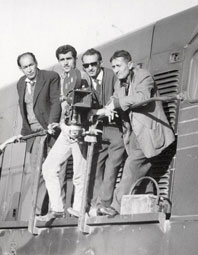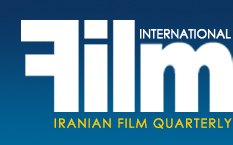|
Cinematographers in the Iranian cinema
Men with the Movie Camera
by Abbas Baharlou
|
 Five years after cinematograph was invented, Mozaffareddin Shah Qajar took a trip to Europe for treatment on April 13, 1900. He was accompanied by his still photographer, Mirza Ebrahim Akkasbashi. He came across cinematograph in Europe and ordered his photographer to buy two Gaumont movie cameras. A cinematographer from Gaumont taught him how to work with those cameras. The “Flower Festival” was in full swing in Paris on August 18, 1900 and the king’s photographer shot scenes from that festival, thus, becoming Iran’s first cinematographer. Five years after cinematograph was invented, Mozaffareddin Shah Qajar took a trip to Europe for treatment on April 13, 1900. He was accompanied by his still photographer, Mirza Ebrahim Akkasbashi. He came across cinematograph in Europe and ordered his photographer to buy two Gaumont movie cameras. A cinematographer from Gaumont taught him how to work with those cameras. The “Flower Festival” was in full swing in Paris on August 18, 1900 and the king’s photographer shot scenes from that festival, thus, becoming Iran’s first cinematographer.
Back in Iran, Mirza Ebrahim Akkasbashi, was frequently ordered by the Shah to make films of lions in Doshan Tappeh, military marches by Cossack troops, performances by court eunuchs, and similar events.
Khan Baba Mo’tazedi was the first professional cameraman of Iran. He had studied electronics in Lausanne (Switzerland) and France and had befriended the son of Leon Ernest Gaumont (famous film producer and owner of film equipment manufacturing plants). He had taken a fancy to cinema after a tour of Gaumont factory in 1914 and brought a Gaumont camera to Iran with which he recorded scenes at family parties. After processing the film at a small laboratory at his house, he screened the films for the same audience.
The camera used by Mo’tazedi had a 3.5-mm Zeiss lens with a focal point of 50 mm enabling him to shoot films at a distance of about 15-20 meters. The camera was not automatic and he had to regulate its speed by spinning a handle. Raw films were not sensitive enough and were reeled on 1 x 1 meter frames before negatives or positives were printed. They put the frames into a tank containing a special solution and then they hung them to dry.
Mo’tazedi’s first task was to film Mohammad Hassan Mirza, the brother and crown prince of the Shah. He used 400 meters of film and developed it in his darkroom.
Soon afterwards, a military coup d’état by Seyed Ziaeddin Tabatabaei on February 21, 1920, led to political and cultural chaos in Iran. Reza Khan, who had done his best to strengthen Cossack troops during the period between the coup and collapse of Qajar dynasty on October 30, 1925; asked Mo’tazedi through Major General Abdollah Tahmasebi to make a film of Cossack troops. The film was then screened in presence of Reza Khan and he paid a considerable sum of money as reward to Mo’tazedi.
The rule of Reza Shah was the acme of Mo’tazedi’s film career. His films recorded various events including presence of Reza Khan at the Assembly of Founders (1925), delivery of monarchial speech at the side of Marmar (Marble) Throne at Golestan Palace (1925), inauguration of the sixth term of the National Consultative Assembly (1926), inauguration of Tehran railroad station (1927), granting diplomas to students of military academy (1927), inauguration of north Iranian railroads (1927), and inauguration of Melli Bank (1927). Mo’tazedi also filmed intertitles for foreign films and was director of photography of the first ever Iranian film, Abi and Rabi (1932) which was directed by Avanes Ohanian. Mo’tazedi shot Abi and Rabi with the same camera he had purchased from Gaumont at a speed of 16 frames per second. Helped by his assistants, Yadollah Taleqani and Paolo Potemkin, and in partnership with Ohanian, he launched Press Film Institute in 1935. Potemkin later shot Ohanian’s second film, Hadji Aqa, the Cinema Actor, in 1936.
Ebrahim Moradi is among three or four filmmakers who are among founders of the Iranian cinema. He learnt photography when he was living with his father in the Soviet Union. Back in Iran in 1922, he had a small Russian camera with German objective lens. He gradually became interested in working with movie camera. He made changes to his camera and converted it into a movie camera which could also screen films. During that period, Moradi decided to make a dramatic film and went to the Soviet Union for the second time. He studied cinematography in Moscow and Leningrad and returned to Iran. He then shot Brother’s Revenge (1932), though the project was never finished. His next film was Capricious (1934) which was shot by his cousin, Ahmad Moradi. As put by Oganians, the film “has good photos.”
SUBSCRIBE
[Page: 44]
|
|
|
|
|
President & Publisher
Massoud Mehrabi
Editors:
Sohrab Soori
Massoud Mehrabi
Translators:
Sohrab Soori
Behrouz Tourani
Zohreh Khatibi
Contributors
Shahzad Rahmati
Saeed Ghotbizadeh
Advertisements
Mohammad Mohammadian
Art Director
Babak Kassiri
Ad Designers
Amir Kheirandish
Hossein Kheirandish
Cover Design
Alireza Amakchi
Correspondents
E.Emrani & M. Behraznia (Germany)
Mohammad Haghighat (France)
A. Movahed & M. Amini (Italy)
Robert Richter (Switzerland)
F. Shafaghi (Canada)
B. Pakzad (UAE)
H. Rasti (Japan)
Print Supervisors
Shad-Rang
Noghreh-Abi
Gol-Naghsh
Subscription & Advertising Sales
Address: 10, Sam St., Hafez Ave., TEHRAN, IRAN
Phone: +98 21 66709374
Fax: +98 21 66718871
info@film-magazine.com
Copyright: Film International
© All rights reserved,
2023, Film International
Quarterly Magazine (ISSN 1021-6510)
Editorial Office: 5th Floor, No. 12
Sam St., Hafez Ave., Tehran 11389, Iran
*
All articles represent views of their
authors and not necessarily
those of the editors
|
|
|

